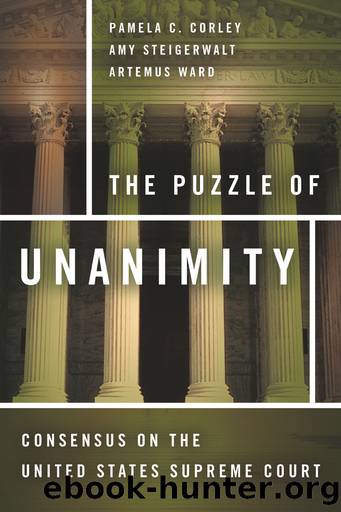The Puzzle of Unanimity by Corley Pamela C.;Steigerwalt Amy;Ward Artemus;

Author:Corley, Pamela C.;Steigerwalt, Amy;Ward, Artemus; [Corley, Pamela C.]
Language: eng
Format: epub
Publisher: Stanford University Press
Published: 2013-08-15T00:00:00+00:00
Figure 3.1. Comparison of the Warren, Burger, and Rehnquist Courts: Percentage of unanimous and highly consensual decisions
Alternatively, highly consensual decisionsâthose with a single dissenting voteâwere most frequent under Warren, at 15 percent. Under Burger, approximately 11 percent resulted in a sole dissent, while only 8 percent were similarly decided under Rehnquist. Notably, when unanimous decisions are coupled with highly consensual decisions, the percentages across Courts are relatively stable, at approximately half of all decisions: 52 percent under Warren, 49 percent under Burger, and 52 percent under Rehnquist. Thus, the reality is that the Court between 1953 and 2004 achieved a high degree of consensus in approximately half of all cases, though we do see some slight variation in whether the justices were able to temper all dissent; again, unanimity was most likely during the more recent Rehnquist tenure. In the following analyses, we seek to explain how the justices reach unanimous as well as highly consensual decisions.
Exploring Unanimous Decisions
We begin by exploring what unanimous cases, as opposed to their more divided counterparts, look like. Given the independent variables explicated in Chapter 2, what differences do we find between unanimous and nonunanimous cases? In this section, we assess the data in an exploratory fashion and then turn, in the subsequent section, to a more rigorous, multivariate analysis of the factors that predict the likelihood of the Supreme Court handing down a unanimous decision on the merits.
What does a unanimously decided case, or a highly consensual case, look like? Unanimous decisions generally address issues that are less controversial overall than others. Perhaps not surprisingly, cases concerning civil liberties are the least likely to be decided unanimously: although 32.2 percent of these cases were unanimous, 44.3 percent of economic cases and 48.8 percent of governmental powers cases were unanimous (see Table 3.1). Similarly, 41.9 percent of civil liberties cases were unanimous or highly consensual compared with 56.2 percent of economic cases and 61.9 percent of governmental powers cases. Additionally, only 25 percent of salient cases were unanimous compared to 41.8 percent of nonsalient cases; 34.2 percent of salient cases were unanimous or highly consensual compared with 53.2 percent of nonsalient cases.
Our initial exploration reveals that unanimous and highly consensual cases reflect at least some strategic calculations. We posit that the identity of the opinion writer may influence the likelihood of unanimity. Most notably, the descriptive analysis reveals that decisions authored by the chief justice were overwhelmingly unanimous: of the 396 decisions authored by the chief justice between 1953 and 2004, 169 (42.7 percent) were decided unanimously and 53.5 percent were unanimous or highly consensual. Alternatively, 39.3 percent of the decisions written by associate justices were unanimous and 50.4 percent were unanimous or highly consensual. Thus, it does appear that chief justices have a slight advantage and can use their power of self-assignment to ensure consensus on the Court. Consensus is not necessarily the outcome, however, when the median justice authors the opinion. In our data, 34.5 percent of the 290 opinions authored by the median justice were in cases decided by a unanimous vote while 41.
Download
This site does not store any files on its server. We only index and link to content provided by other sites. Please contact the content providers to delete copyright contents if any and email us, we'll remove relevant links or contents immediately.
The Crisis in America's Criminal Courts by William R. Kelly(228)
Hollow Courts (2022) by Unknown(225)
I Dissent : Great Opposing Opinions in Landmark Supreme Court Cases by Mark Tushnet(160)
Mediation, Conciliation, and Emotions by Ladd Peter D.;Blanchfield Kyle E.; & Kyle E. Blanchfield(160)
Equity and Gender by Ellen Frankel Paul(154)
Settling Disputes by Linda Singer(150)
A Lawyer in Indian Country by Alvin J. Ziontz(145)
The Puzzle of Unanimity by Corley Pamela C.;Steigerwalt Amy;Ward Artemus;(136)
How to Master Commercial Mediation by Richbell David;(132)
Judge and Jury by WILLIAM BERNHARDT(127)
The Nominee by Alan P. Woodruff(124)
In Defense of the Constitution by George W. Carey(123)
Public Actors in International Investment Law by Catharine Titi(122)
Madam Chief Justice by W. Lewis Burke Joan P. Assey(121)
War Crimes and the Culture of Peace by Louise Arbour(118)
Law, Courts, and Justice in America by Howard Abadinsky(116)
The National Security Court System by Sulmasy Glenn;(112)
The Trial and Execution of Mark and Phillis, Slaves of Capt. John Codman by Abner Cheney Goodell(110)
Kaleidoscope by Alan P. Woodruff(103)
